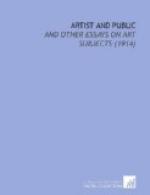It is not until the beginning of what is known as the Romantic movement, under the Restoration, that the misunderstood painter of genius definitely appears. Millet, Corot, Rousseau were trying, with magnificent powers and perfect single-mindedness, to restore the art of painting which the Revolution had destroyed. They were men of the utmost nobility and simplicity of character, as far as possible from the gloomy, fantastic, vain, and egotistical person that we have come to accept as the type of unappreciated genius; they were classically minded and conservative, worshippers of the great art of the past; but they were without a public and they suffered bitter discouragement and long neglect. Upon their experience is founded that legend of the unpopularity of all great artists which has grown to astonishing proportions. Accepting this legend, and believing that all great artists are misunderstood, the artist has come to cherish a scorn of the public for which he works and to pretend a greater scorn than he feels. He cannot believe himself great unless he is misunderstood, and he hugs his unpopularity to himself as a sign of genius and arrives at that sublime affectation which answers praise of his work with an exclamation of dismay: “Is it as bad as that?” He invents new excesses and eccentricities to insure misunderstanding, and proclaims the doctrine that, as anything great must be incomprehensible, so anything incomprehensible must be great. And the public has taken him, at least partly, at his word. He may or may not be great, but he is certainly incomprehensible and probably a little mad. Until he succeeds the public looks upon the artist as a more or less harmless lunatic. When he succeeds it is willing to exalt him into a kind of god and to worship his eccentricities as a part of his divinity. So we arrive at a belief in the insanity of genius. What would Raphael have thought of such a notion, or that consummate man of the world, Titian? What would the serene and mighty Veronese have thought of it, or the cool, clear-seeing Velazquez? How his Excellency the Ambassador of his Most Catholic Majesty, glorious Peter Paul Rubens, would have laughed!
It is this lack of sympathy and understanding between the artist and his public—this fatal isolation of the artist—that is the cause of nearly all the shortcomings of modern art; of the weakness of what is known as official or academic art no less than of the extravagance of the art of opposition. The artist, being no longer a craftsman, working to order, but a kind of poet, expressing in loneliness his personal emotions, has lost his natural means of support. Governments, feeling a responsibility for the cultivation of art which was quite unnecessary in the days when art was spontaneously produced in answer to a natural demand, have tried to put an artificial support in its place. That the artist may show his wares and make himself known, they have created exhibitions; that he may be encouraged they have instituted




